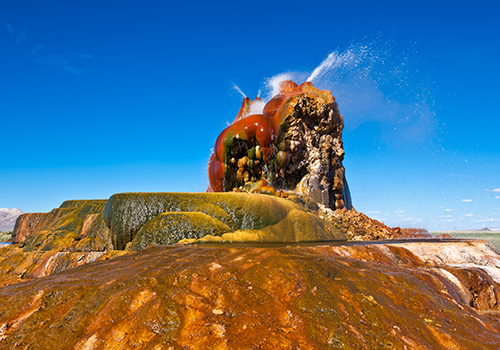
Fly Geyser is located on a 3800-acre parcel of land on the edge of the Black Rock Desert in Northern Nevada, Western United States. You may think it is a natural formation but it is in fact manmade. Manmade by accident, actually. This happened in 1964 after a geothermal power company drilled a test well at the site.
This is not the first geyser if truth be told. Way back in 1916, the first geyser was formed in a bid to source water for irrigation purpose. Being a short distance from the Fly Geyser, it was also at 200 degrees with minerals, not at all suitable for farming. It was then abandoned and over time, a 10 to 12 foot cone of calcium carbonate was formed.
The original geyser ceased hydraulic activity once the pressure was released at Fly Geyser. It now lies dry, just a few hundred feet south, from the new geyser looking like a miniature volcano.
Due to the multiple spouts that comprise Fly Geyser, it has not created one single cone, like the original geyser but multiple conic openings on a mound with sediments that are now 6 foot tall. It is streaked in brilliant hues of red and green, thanks to the thermophilic algae that thrives in the wet and hot conditions created by the geyser. It looks almost other-worldly in appearance, with water emerging from various places. The geyser releases mineral-enriched water in a spray form, at the height of about 5 feet. While the original Fly Geyser no longer hisses steaming water, the other two additional geysers in the area do.
Though the attraction is located on private land and not open to tourists, visitors who make arrangements ahead of time are able to get a closer look for a fee. The fees are considered a donation and are used to support Fly Ranch and the Friends organisation. Visitors are not permitted to soak in the hot springs due to a lack of insurance coverage.
Hope you found this an interesting read. If you are planning a trip to Nevada, don’t forget to book your tickets for Fly Geyser in advance.